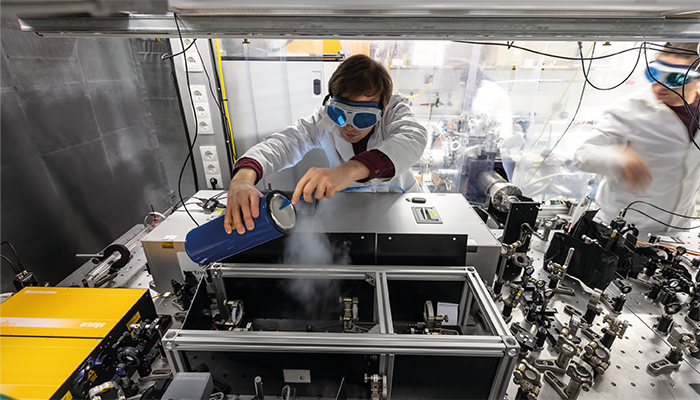
Tracing PFAS to the Source
A new nuclear magnetic resonance (NMR) spectroscopy-based method to fingerprint organofluorine compounds, including PFAS, could enable authorities to trace these persistent pollutants in the environment to their sources.
Led by two researchers from The University of Texas at Austin, USA – Cornelia Rasmussen, Institute for Geophysics, and David Hoffman, Department of Molecular Biosciences – the study focused on developing a method for position-specific isotope analysis of carbon-fluorine (C-F) bonds in organofluorine molecules. Traditional isotope ratio mass spectrometry (IRMS) methods require the complete combustion of samples to CO2, which is problematic for organofluorine compounds due to the strength of the C-F bonds. Instead, the UT Austin team turned to 19F NMR spectroscopy because it can assess carbon isotopes without breaking these robust bonds.
"Ultimately we will be able to trace molecules and see how they move," said Rasmussen, who co-led development of the technique, in a press release. "For example, whether they just stay where they got dumped or whether they're moving downstream."
Click to read a full writeup of the study
An Automated Avenue for Microplastic Detection
An AI-based microspectroscopy imaging identification system, PlasticNet, can detect microplastics with high accuracy – and could be used in wastewater treatment and food production plants. The tool, developed by researchers at University of Waterloo, Canada, uses a deep learning convolutional neural network architecture to automatically detect images generated by focal plane array (FPA)-based micro-fourier transform infrared (FT-IR) microscopy.
After training PlasticNet with over 8,000 spectra of virgin plastic, and then retraining the tool using non-virgin plastics, PlasticNet was able to successfully classify 11 types of common plastics with 95 percent accuracy. The team also demonstrated a 17.3 percent improvement in identifying polypropylene microplastics compared with other environmental datasets.
“I was surprised by the efficiency of deep learning in this context,” says lead author Ziang Zhu. “With PlasticNet, we received precise and reliable results in a field that is known for often dealing with complex and variable data. It’s really opened up avenues for future investigations in environmental science.”
Click to read a full writeup of the study
Also in the News…
Researchers from Texas A&M University and the University of Notre Dame collaborated to examine plastic nanoparticles in water samples obtained from two open oceans with shrinking surface bubble deposition (SSBD). The technique was originally developed for DNA analysis combining electron microscopy and surface-enhanced Raman spectroscopy and repurposed for this study to enable nanoplastic size and morphology determination – a measure that current techniques, such as gas chromatography and mass spectroscopy, cannot provide. The team discovered nanoplastics made of nylon, polystyrene, and polyethylene terephthalate. “The nanoplastics we found in the ocean were distinctively different from laboratory-synthesized ones,” said corresponding author Tengfei Luo in a press release. “Understanding the shape and chemistry of the actual nanoplastics is an essential first step in determining their toxicity and devising ways to mitigate it.” Now, the scientists are hopeful their study will help design and conduct more accurate toxicity studies.
Researchers have developed the world’s first broadband UV dual-comb spectrometer, which they are using to continually measure air pollutants and observe their reaction with the environment in real time. The team, led by Birgitta Schultze-Bernhardt from the Institute of Experimental Physics at Graz University of Technology, demonstrated the proof of concept by testing formaldehyde.
(Micro)plastic pollution of oceans may be expanding more rapidly, following the discovery of microplastics in a remote marine protected area. The scientists from Helmholtz Centre for Environmental Research, Leipzig, Germany, employed Fourier-transform infrared spectroscopy (FT-IR) to analyze samples. Plastic particles from each sample were sorted by size and counted and analyzed using a “special form” of infrared spectroscopy. The findings of the study showcase a “widespread distribution and elevated concentrations of plastic items in the middle of the ocean, far from human activities” – urging for more efficient management of (micro)plastic pollution.
A new surface-enhanced Raman spectroscopy (SERS) technique, with a silver-coated cellulose membrane, can detect pesticide contamination below the surface of fruits, revealing that pesticides can penetrate beyond the peel into the pulp, suggesting that current food safety practices may not fully prevent pesticide ingestion.
In a study, scuba divers collected litter from a lakebed – counting 673 plastic items. Attenuated total reflection Fourier transform infrared spectroscopy was used to characterize the plastic polymers – data that the researchers believe can be used in conjunction with microplastics data to determine their source.




